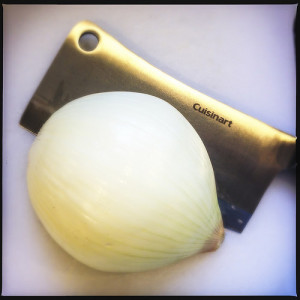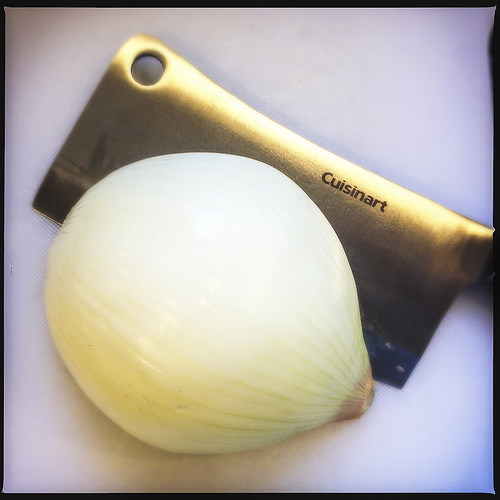Short Answer:
Yes, onion is Paleo!

That Bulb That Makes You Cry..
Onion is commonly used as vegetable and is the most cultivated species of the genus allium. It has been used as a food source for years.
Onion is one of the staple foods always available in the pantry. It is healthy, cheap, flavorful and is very versatile that it can be used with any recipe that you would like to cook. It is a great way to add flavor to your meals. Onions can be eaten raw in sandwiches or salads or can be cooked as ingredient for dishes.
Types of Onions
Onions range in size, color and shape depending on its variety. Common onions are normally available in three colors. The yellow or brown onions are the ones normally used every day and are fully-flavored. They turn brown when caramelized and gives the sweet taste to a dish.
Red onion, sometimes purple, is a good choice for fresh use because it is sweeter and mild. Its color livens up the dish. It is commonly used in salads, sandwiches or can be grilled.
White onion is a strong onion and has a strong flavor. It is not generally used as raw. It has a golden color and sweet taste when cooked.
Shallot is a small, brown, milder onion that has a less bitter taste and gives a sweet taste when cooked. It is ideal to be used with other milder vegetables like mushrooms and asparagus.
Scallion or spring onion is small, slender and green in color with long hollow leaves. It is milder than other onions and are used often as raw in salads and to top on some dishes.
Chive is the smallest of all the onions and is often mistaken as scallions. It is normally used for dips, fish and soup meals. It is dark brown in color and bulbous.
Benefits of Onions
Onions may bring tears to your eyes or makes your breath pungent but they certainly give delight to your taste buds. They have many health benefits.
- Onion contains a lot of nutrients. It is very low in saturated fat, cholesterol and sodium. It is a good source of fiber, vitamin B6, folate, potassium, manganese and Vitamin C.
- The phytochemicals in onion can help the body utilize vitamin C more effectively.
- Onion is a good source of sulphur. We already know that sulphur-rich vegetables contain significant anti-cancer properties, help manage glucose tolerance by regulating blood sugar level and provide benefits to connective tissue. Sulfur is required in most of the connective tissue formation.
- Several servings of onion per week is said to have reduced risks in having some types of cancer. With a consumption of 1-7 servings of onion, it has provided risk reduction in having colorectal, laryngeal and ovarian cancer.
- Onion provides protection for the heart and blood vessels, preventing heart attack.
- Studies have found that onion can help increase bone density and it may be beneficial to women at menopausal age.
- Onion is rich in polyphenols and quercetin, a flavanoid antioxidant. It provides anti-inflammatory benefits, preventing the oxidation of fatty acids in the body. The lower the level of oxidized fatty acids, the fewer pro-inflammatory messaging molecules, thus, balanced level of inflammation.
Other Uses of Onions
Onions are naturally pest resistant. The feature of onions that make you cry after cutting them is the one that make the pests weep. The pungent juice of the onion can be used as moth repellent and can be rubbed on the skin to prevent insect bites. When applied in the scalp, it is said to promote hair growth.
Onions were used as preventive medicine from epidemics and cholera and were prescribed by the doctors in the 16th century to help with infertility in women.
Cooking meat with onion reduces the formation of HCAs (heterocyclic amines), a carcinogenic compound.
Cooking Onion
While onion is mostly used as seasoning to dishes, it is recommended to sauté and caramelize it for great flavor and nutrition. It is suggested to let the onion sit for a couple of minutes after slicing before cooking or consuming to allow its microsinase enzyme content release more sulphur compounds and make them more resistant to heat.
Click here to see what other vegetables are Paleo.
What Experts Say About Onion.. Is It Paleo?
“Eating more garlic, onions, kale and greens improve blood fluidity. That is likely part of the mechanisms for why the Wahls Protocol™ can help people with MS and those with heart disease.” – Terry Wahls
“If it’s beneficial allyl sulfur compounds you want to consume, eating your alliums raw and sliced is the ticket. Heat breaks down the compounds. The only problem is that those same allyl sulfur compounds that might fight cancer, boost antioxidant status, and ward off liver damage are the very things that make raw onion and garlic so pungent and unpalatable”. – Mark Sisson
All you ever wanted to know about Onion and Paleo
The Paleo Diet. Livers and Onions
http://thepaleodiet.com/liver-and-onions/
Mark’s Daily Apple. Why You Should Eat Sulfur-Rich Vegetables
http://www.marksdailyapple.com/why-you-should-eat-sulfur-rich-vegetables/#axzz3VwxlNzLG
Mark’s Daily Apple. 7 Foods You Don’t Need to Buy Organic
http://www.marksdailyapple.com/7-foods-you-dont-need-to-buy-organic/#axzz3VwxlNzLG
Paleo Leap. Paleo Diet Food List
http://paleoleap.com/paleo-diet-food-list/
Paleo Grubs. Foods You Can Eat on the Paleo Diet
http://paleogrubs.com/paleo-diet-food-list
Paleo Porn. Are White Onions Paleo?
http://paleoporn.net/q/are-onions-paleo/
Paleo Porn. Are Red Onions Paleo?
http://paleoporn.net/q/are-red-onions-paleo/
Paleo Diet Food List. Onion
http://www.originaleating.com/paleo-diet-food-list/vegetable/onion/
Paleo Diet. Why Onions Are Good For You
http://paleodiet.co.uk/why-onions-are-good-for-you/
Paleo Parents. Sneak Peek at Real Life Paleo: Pickled Onions on Everything
http://paleoparents.com/featured/rlp-pickled-onions-everything/
The World’s Healthiest Foods. Onions
http://www.whfoods.com/genpage.php?tname=foodspice&dbid=45
Other names for Onion
Bulb onion, common onion
Did we miss anything?
Comment below and let us know what you think. Do you agree with our conclusion?
photo credit: 365 weekly theme, #31.4, tools

